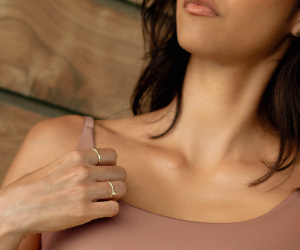Since their inception in the mid-60s, surgery with silicone gel breast implants has consistently been one of the most commonly performed cosmetic procedures in the world – and yet, the devices have seen relatively little evolution by their most prominent manufacturers in the last 50 years.
1st Generation
While breast implants have existed since the late 19th century, they weren’t made of silicone or saline until the 1960s. Previously used materials have included ivory, glass, ox cartilage, ground rubber, and polyester.Injections with raw, liquid silicone were received by an estimated 50,000 women before surgeons and manufacturers realized that the silicone needed to be housed in barrier shells to keep it from entering the bloodstream and causing disastrous side effects.
In 1961, American plastic surgeons Frank Gerow and Thomas Cronin partnered with Dow Corning Corporation produced the first shelled, silicone gel-filled breast implant, which was first used surgically the following year.
This first generation of silicone breast implants were characterized by Dacron patches (made of a synthetic form of polyester), thick (roughly 0.25 mm) shells, and thick and viscous silicone gel.
Quickly becoming popular despite controversy around the practice of breast augmentation, this initial generation was manufactured until the early 70s and was often associated with capsular contracture (i.e. the formation of a hard, fibrous capsule that contracts the implant within itself) and implant rupture.
2nd Generation
The second generation were introduced a decade after the first, with implant shells thinned to nearly half their thickness and thinner, more liquid-y gels used to give the implants a softer feel. But these changes, along with stopping the use of Dacron patches, did not help in addressing high rates of capsular contracture.
3rd Generation
Thick, silica-reinforced shells (the likes of which can still be found in fourth and fifth generations) characterize this generation in manufacturers’ attempts to make breast implants stronger. Unfortunately, the thinner, syrupy gel that was used as filling would bleed much farther into the bloodstream when these shells became compromised.
This generation was marked by controversy and fear around the use of silicone breast implants during the 80s and 90s.
In 1992, the US FDA called for a moratorium on silicone gel breast implants due to concerns that this generation posed more of a health risk than previously thought. This moratorium ended up staying in effect until 2006, when the FDA approved a fourth generation of silicone “responsive gel” implants.
PIP, a large French implant manufacturer, also became embroiled in a prominent scandal and was eventually liquidated in 2010 due to their use of unapproved, non-medical-grade silicone gel.
4th & 5th Generations
It’s no coincidence we address fourth and fifth generations simultaneously, as the only significant changes they heralded were related to silicone gel cohesivity.
In the 90s, shells were further strengthened, and more cohesive versions of silicone gel were used to minimize complications related to gel leakage. Because these cross-linked silicone gel molecules retain their form (retaining their shape even when cut), such filling is not likely to “bleed” or ooze if the shell breaks down.
The fourth generation is associated with the responsive gel implants that the FDA cleared in 2006 (which is most common in round implants and has moderate cohesivity), while the fifth is associated with the more highly form-stable gels that characterize “gummy bear” implants. Highly cohesive form-stable implants are typically made in a teardrop or anatomical shape, with greater lower pole fullness and a sloping upper pole.
But “gummy bear” form stability has proven to be both a blessing and a curse, as patients have complained the 5th generation implants look and feel stiff and unnatural, especially when lying down.
6th Generation Motiva Implants®
Unfortunately, the silicone implants available from most large manufacturers today are not very different from the versions sold in the 90s. Capsular contracture, rupture, seromas, and even breast implant-associated cancer (known as breast implant-associated anaplastic large cell lymphoma, or simply BIA-ALCL) continue to be issues that plague breast implant recipients.
Recognizing this industry-wide complacency in implant safety, Establishment Labs® has taken a patient-centric approach in developing and incorporating revolutionary technologies in its Motiva® products to maximize both safety and aesthetic outcomes.
MOTIVA IMPLANTS® possess several patented, first-of-their-kind features that have disrupted the breast implant industry. Each feature was incorporated to minimize safety concerns that previous and current implant manufacturers have failed to adequately address. These include:
- BLUSEAL®: a visual indicator that allows for 100% confirmation that a barrier layer is intact, to minimize any risks of gel bleed
- QID®: a passive RFID microtransponder system for non-invasive, immediate traceability and verification of implant information, including potential recall
- ERGONOMIX®: These premium Motiva Implants® are manufactured with ProgressiveGelTM Ultima, a proprietary silicone gel that provides the most natural look, feel, AND movement, whether a patient is standing, in motion, or lying down
- TRUEMONOBLOC®: Special attention has been paid to providing all Motiva Implants® with uniform tensile strength (i.e. equal performance under stress at any point on the implant) by chemically bonding the implant gel, shell, and patch – thus, they are designed to prevent implant rupture
A Brief Note on Saline Implants
Saline implants were first introduced into the breast implant market in 1964. While the earliest saline implants were associated with high rates of deflation, design modifications to their shells have allowed a significant delay in when eventual deflation may occur. They briefly became more popular in the North American market as an alternative to silicone-filled implants during the FDA moratorium between 1992 and 2006. Today, however, silicone gel implants comprise most devices used in breast augmentation surgery, owing to the clinical efficacy and safety of newer-generation models, as well as the inevitable deflation of saline implants. Silicone gel implants are also far more popular among patients because of their significantly more natural look and feel.
To learn more about the Motiva® range, feel free to browse OUR WEBSITE, contact a MOTIVAIMAGINE CENTER® OR PARTNER SURGEON/CLINIC, or contact us DIRECTLY.

